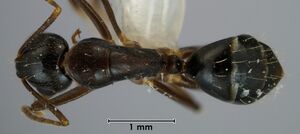Camponotus fraseri
| Camponotus fraseri | |
|---|---|

| |
| Scientific classification | |
| Kingdom: | Animalia |
| Phylum: | Arthropoda |
| Class: | Insecta |
| Order: | Hymenoptera |
| Family: | Formicidae |
| Subfamily: | Formicinae |
| Tribe: | Camponotini |
| Genus: | Camponotus |
| Species: | C. fraseri |
| Binomial name | |
| Camponotus fraseri McArthur, 2008 | |
The type material was collected from a honey bait.
Identification
McArthur (2008) - A member of the C. claripes group (McArthur 2007a), a close relative of Camponotus insipidus (as C. minimus). Both lack erect setae on the underside of the head and have wide frontal carinae. The distinctive short sloping setae present on the scapes of this species are absent in C. insipidus.
Keys including this Species
Distribution
Latitudinal Distribution Pattern
Latitudinal Range: -26.25° to -35.26666667°.
| North Temperate |
North Subtropical |
Tropical | South Subtropical |
South Temperate |
- Source: AntMaps
Distribution based on Regional Taxon Lists
Australasian Region: Australia (type locality).
Distribution based on AntMaps
Distribution based on AntWeb specimens
Check data from AntWeb
Countries Occupied
| Number of countries occupied by this species based on AntWiki Regional Taxon Lists. In general, fewer countries occupied indicates a narrower range, while more countries indicates a more widespread species. |

|
Estimated Abundance
| Relative abundance based on number of AntMaps records per species (this species within the purple bar). Fewer records (to the left) indicates a less abundant/encountered species while more records (to the right) indicates more abundant/encountered species. |

|
Biology
Castes
   
| |
| . | |
Nomenclature
The following information is derived from Barry Bolton's Online Catalogue of the Ants of the World.
- fraseri. Camponotus fraseri McArthur, 2008: 119, figs. (w.) AUSTRALIA (South Australia).
- Type-material: holotype minor worker, 3 paratype minor workers.
- Type-locality: holotype Australia: South Australia, Marine CP, 35°03’S, 138°31’E, 2.xi.2003 (J. Fraser & N. Skinner); paratypes with same data.
- Type-depositories: SAMA (holotype); ANIC, NHMW, SAMA (paratypes).
- Status as species: McArthur, 2010: 68; McArthur, 2014: 150.
- Distribution: Australia.
Unless otherwise noted the text for the remainder of this section is reported from the publication that includes the original description.
Description
Worker
Measurements: HL = 0.91HW + 0.36, (R2 = 0.92, n =5); PW = 0.68HW + 0.15, (R2 = 0.87, n =5); CW = 0.48HW -0.10, (R2 = 0.84, n =5).
Minor. Mesosoma: dorsum of pronotum, mesonotum and propodeum evenly convex, angle well rounded about 150°; declivity mostly straight, ratio propodeal dorsum / declivity nearly 2; erect setae and short flat-lying setae on mesosoma sparse; integument on side of mesonotum and propodeum sharply striate. Node: anterior mostly straight, convex above; posterior flat; summit blunt. Appendages: tibiae with plentiful short setae raised to 20°; scapes with plentiful short setae raised to 30°. Head: underside in lateral view without erect setae; in front view, setae sparse; sides straight, parallel; vertex convex; frontal carinae width < HW/3; maximum head width occurs at eye centres; clypeus anterior margin projecting, convex. Colour: dark brown, limbs and front of head lighter.
Type Material
Holotype: One minor worker pinned in South Australian Museum “S. A. Marino CP 35°03’S 138°31’E honey 11 pm 2/11/2003 J Fraser N Skinner” Paratypes: Three minor workers with same data pinned in each of SAMA, Australian National Insect Collection and Naturhistorisches Museum Wien, Vienna.
Type Material
- Holotype, worker, Marino Conservation Park, 35°03'S 138°31'E, South Australia, Australia, 35°03′0″S 138°31′0″E / 35.05°S 138.516667°E, South Australian Museum.
- Paratype, 3 workers, Marino Conservation Park, 35°03'S 138°31'E, South Australia, Australia, 35°03′0″S 138°31′0″E / 35.05°S 138.516667°E, Fraser,J. & Skinner,N., ANIC32-053464, Australian National Insect Collection.
- Paratype, 3 workers, Marino Conservation Park, 35°03'S 138°31'E, South Australia, Australia, 35°03′0″S 138°31′0″E / 35.05°S 138.516667°E, Naturhistorisches Museum Wien, Vienna.
- Paratype, 3 workers, Marino Conservation Park, 35°03'S 138°31'E, South Australia, Australia, 35°03′0″S 138°31′0″E / 35.05°S 138.516667°E, South Australian Museum.
Etymology
Named after Jack Fraser, a volunteer worker at Marino Conservation Park.
References
- Heterick, B.E. 2022. A guide to the ants of Western Australia. Part II: Distribution and biology. Records of the Western Australian Museum, supplement 86: 247-510 (doi:10.18195/issn.0313-122x.86.2022.247-510).
- McArthur, A. J. 2008. New species of Camponotus (Insecta: Hymenoptera: Formicidae) from Australia. Annalen des Naturhistorischen Museums in Wien. Serie B für Botanik und Zoologie. 109B:111-129.
References based on Global Ant Biodiversity Informatics
- McArthur A. J. 2008. New species of Camponotus (Insecta: Hymenoptera: Formicidae) from Australia. Annalen des Naturhistorischen Museums in Wien. B, Botanik, Zoologie 109: 111-129.
